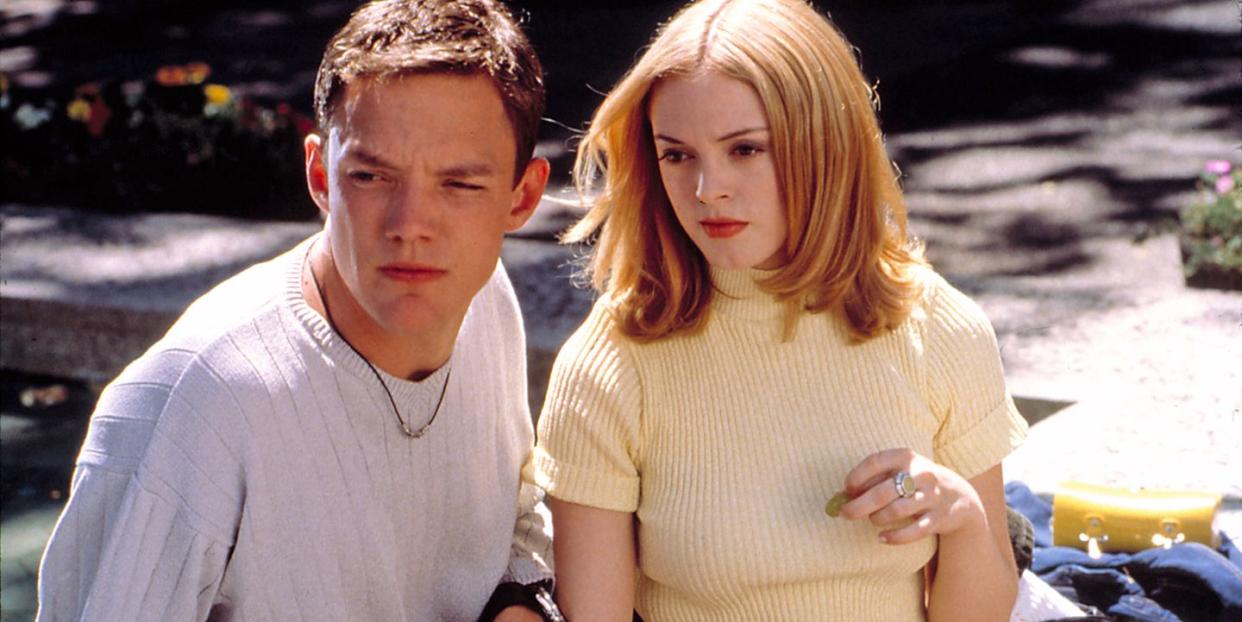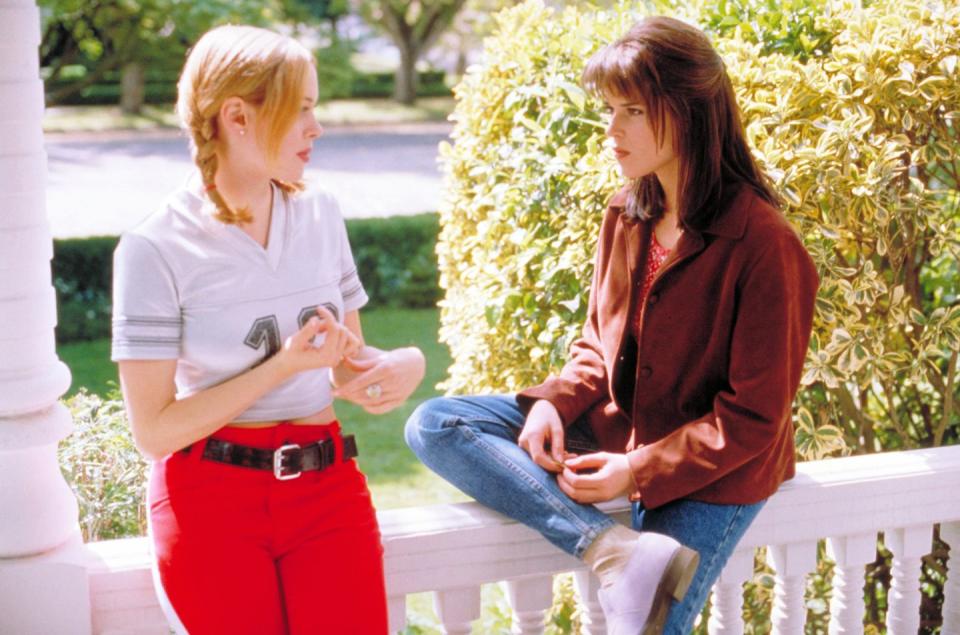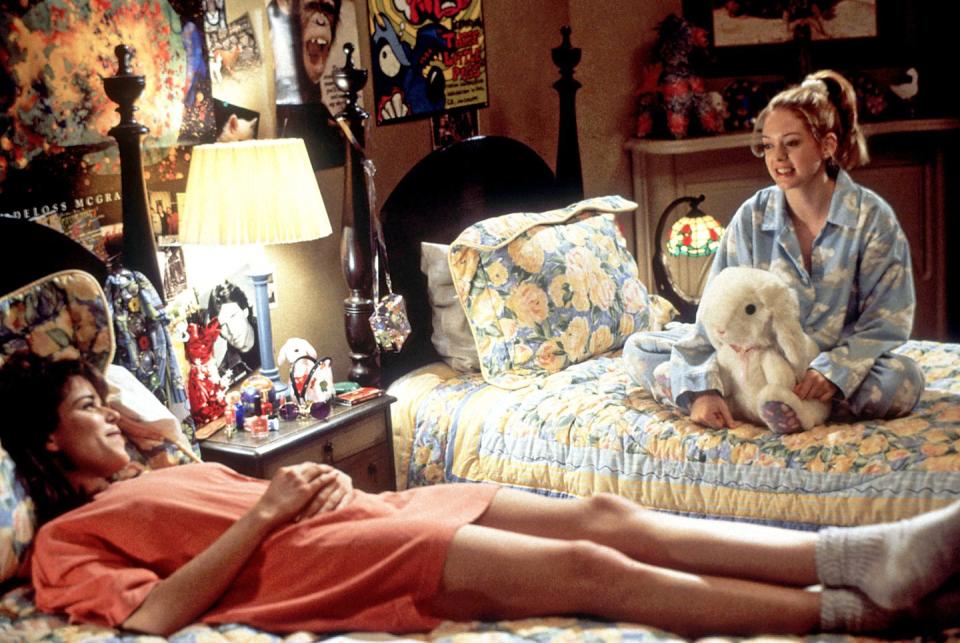How Rose McGowan’s Tatum Riley Redefined the Scream Queen

- Oops!Something went wrong.Please try again later.
- Oops!Something went wrong.Please try again later.
When Rose McGowan read the script for Scream, she knew the kind of role she was auditioning for. The 1996 Wes Craven movie was a satirical take on the classic slasher flick, centering on a group of small-town high schoolers targeted by the serial killer Ghostface. The character of Tatum Riley was pegged as the slutty victim, the “disposable, big-boobed” best friend who would say funny lines, look hot, and ultimately get killed. But that’s not how McGowan was going to play it. The then-19-year-old was going to “make every single moment” she appeared onscreen count, so that when Tatum was inevitably murdered in gruesome fashion, the film would be “less fun” without her.
“I came to win,” McGowan tells ELLE.com. That mission started before she secured the role.
Thanks to the sardonic sass McGowan brought to her audition, she was the top choice for the role over the likes of Rebecca Gayheart and Melinda Clarke. But her overzealous lawyer’s response to the original offer caused drama with Dimension Films, the production company owned by the Weinstein Brothers. “They offered me $50,000 but I had this really stupid lawyer who went back asking for $200,000,” she recalls. “Harvey Weinstein himself freaks out. I didn't even know what he looked like then. He refused to let them hire me, so they made me take a screen test three more times.”
During her final audition, McGowan learned that fellow brunette Neve Campbell landed the lead role. She realized they looked too similar and that might prohibit her casting. Then she clocked the salon-blonde locks of producer Cathy Konrad and knew exactly what she needed to do.
“I turned to Cathy,” McGowan remembers. “I said, ‘I just love your hair! Who's your hairdresser? I want to turn it blonde tomorrow.’ [They] were all staring at each other like, ‘Oh my god, she could be blonde. We can cast her!’”
Sure enough, McGowan finally landed the role, but while the rest of the main cast was paid $100,000 each, she says Weinstein refused to pay her more than the original offer: “He never paid me a cent more than 50 to punish my lawyer and me.”

McGowan knew who Tatum was even though their lives had little in common. McGowan grew up in a cult in Italy before her family moved to Oregon, where she emancipated herself from her parents at 15. Tatum’s suburban existence was something McGowan had only seen in the movies. “That was not my life whatsoever, but I knew that life, and I watched that life growing up, and when I came to America, people were kind of like that,” she says.
The day before filming began, McGowan put herself in charge of her character’s wardrobe after seeing the tomboyish look Scream’s costume designer Cynthia Bergstrom came up with. “She was way out of her depth with me,” McGowan remembers. “She tried to put me in overalls with stacked Keds. She goes, ‘They're very now,’ and I looked at her and said, ‘They're very never,’ and walked out of the room.” McGowan jumped into a cab to pick out Tatum’s wardrobe at the local mall, purchasing “quadruple of everything”: cloud pajamas, a lime-green turtleneck sweater, two patterned skirts, and a “10” T-shirt.
“I would never in my life wear a ‘10’ shirt,” McGowan chuckles. ”I would never want someone reading my breasts if I could avoid it. But Tatum would definitely wear one. Not in a way that's like, ‘I’m awesome,’ but in a way that’s like, ‘Yeah, I’m a ten, what’s up?’
McGowan wanted to show there was a side to Tatum that wasn’t just a “sarcastic throwaway bitch.” That way, when she died, you'd be emotionally affected: “Everything I did had to be cute, but not in a saccharine way. She has to be sassy, but not bitchy. Warm, but caustic.” McGowan had the grungy posters of the Indigo Girls in Tatum’s bedroom taken down, to the ire of production designer Bruce Alan Miller, and requested kitten posters put up in their place. “I wasn't mean,” she explains. “I was just like, ‘I would rather hurt your feelings than please your ego.’ Subliminally, everything I was putting on these walls, everything I was putting on my body, was soft and sweet and cuddly.”

Craven’s set was the best filmmaking experience of McGowan’s career. She’d never actually watched the director’s films, nor was she a fan of horror movies in general, but she felt a paternal connection with the horror giant, who created a loving, safe environment during those eight weeks of shooting. “I'd had enough trauma in my life,” she says. “I don't like jump scares much. It was that simple. But I liked my experience with Wes from how I knew him, and not from watching his work.”
Tatum’s death scene is one of the most iconic demises in the Scream franchise. As the party rages at her boyfriend Stu’s (Matthew Lillard) house, she heads down to the garage to get beer. The door is locked when she tries to return, and when the lights shut off, she attempts to leave via the garage doors. Ghostface reveals himself and Tatum is soon chucking beers and fighting for her life. She’s killed while trying to escape through the dog flap of the rising garage door.
They filmed the scene through an all-nighter, and though there was a stunt double on hand, McGowan performed every part of it. “She didn't look like me, so I was not gonna work this hard on a movie, on my character, and then have a critical scene disbelieved,” McGowan says. “I did every single piece of it because [the camera was] gonna be on my ass and my face, and the stunt woman’s body is not the body they've seen in these outfits. I'll take the pain.”
They shot the death scene more than 20 times from every angle, in what McGowan describes as freezing cold temperatures. Her outfit certainly wasn’t designed for the chill, and that was evident in the film. “Nobody told me about the nipple situation,” she laughs. “I wasn't powerful enough to warrant seeing the dailies, so I never knew. But for years people would come up to me or write online to say I wore prosthetics, and I'm like, ‘Why?’”
Craven used storyboards to map out each scene and what was in the script was “very much” shot on the day. Before her death, Tatum believes her boyfriend is pranking her, and McGowan got to deliver some cracking lines including, “Cute, what movie is this from? I Spit on Your Garage?” and “Cut, Casper. That's a wrap!” But she improvised Tatum’s final words—“No! Mom”—before her neck is broken and head squashed between the garage door and its frame. “I thought it was really poignant,” McGowan explains.
Part of the reason she didn’t scream was that she had an aversion to it. “I told Wes I can yell but I cannot scream, and I still can't,” McGowan says. “My voice goes mute.” Craven didn’t asked her to try during her audition, so it wasn’t until they got to the scene that he realized their dilemma. But McGowan didn’t view it as a problem—just another way to subvert the Scream Queen trope. “That was the nail in the proverbial coffin of my desire to smash being disposable as a female, an archetype, and a human onscreen, or have people digest me like a McDonald's and not remember me again,” she says.
Scream went on to be a blockbuster hit and spawn several sequels. Though Tatum died, it didn’t need to be the end of her journey. As McGowan has pointed out before, her character had twin beds, and if the producers were smart, they could’ve brought her back as an evil twin. Unfortunately, one of those producers was Harvey Weinstein. The convicted rapist sexually assaulted McGowan during the 1997 Sundance film festival, so there was no chance of her return to the franchise after he’d seen fit to blacklist her in Hollywood.
Still, McGowan looks back on the film with pride for what she achieved, the performance she delivered, and the role it played in her mission to become the leader, author, and activist she is today. “You can be both proud of your work and dislike a system, and I did everything I could to make [sure] I was in that film so I could subvert the dominant paradigm,” she says. “I thought about it from all angles and I wanted to make everything that I ever did, especially with Scream, be better than what you're supposed to get. Elevate, baby.”
You Might Also Like

